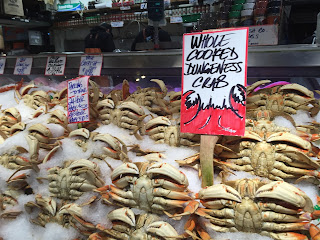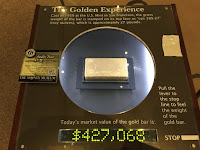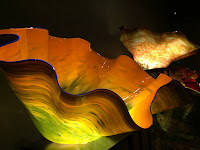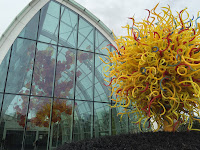You'll look for the iconic red "Public Market Center" sign with clock above the building. Before you enter the market, you can do good by donating your change to the bronze cast piggy bank. Rachel the Piggy Bank serves as the market mascot and a way to collect money to the Pike Place Market Foundation. The foundation provides many services including a food bank, senior center support, and preschool financial assistance. The piggy bank has raised over $200K.
Once in the market, you don't need to go far to see the fishmongers
throwing salmon over the counter. It began as a way to increase efficiency and now seen as the iconic action in the market. You might have seen such action on shows such as Frasier and The Learning Channel (TLC). While the market has fame for fish, you can find so much beautiful, bright colored produce and flowers too. If you can't buy food that will spoil, look for pasta, nuts, and chocolates. With over 500 shops, you'll also find crafts and a variety of restaurants, including ethnic - Persian, Thai, Japanese, Mexican, and Italian.
Walk around the market building too and you'll enjoy views of Puget Sound and the Olympic Mountains. I kept on walking. It can take less than ten minutes from the market to reach Pier 59.
In my article about the Frankfurt, Germany market, I listed the top farmers' markets according to Frommer book. Of course, Pike Place Market makes the list. When Country Living magazine made it's list of top 14 markets per "The Best Farmers' Markets in America" article, Pike Place listed at the top. Here's their full list:
1. Pike Place Farmers' Market - Seattle, Washington, June-November
2. Historic Soulard Farmers' Market - St. Louis, Missouri, year-round Wed.-Sat., since 1779
3. Crescent City Farmers Market - New Orleans, Louisiana, Tue.-Sat.
4. Union Square Farmers Market - New York, New York, Sat. until Nov. 23
5. Baltimore Farmers' Market & Bazaar - Baltimore, Maryland, April-Dec.
6. Brattleboro Winter Farmers' Market - Brattleboro, Vermont, Sat. Nov. - March
7. Charleston Farmers' Market - Charleston, South Carolina, Sat., April - Dec.
8. Des Moines Downtown Farmers' Market - Des Moines, Iowa, Sat., May - Oct.
9. Portland Farmers Market at PSU - Portland, Oregon, Sat.
10. Rowayton Farmers' Market - Rowayton, Connecticut, Fri.
11. Sag Harbor's Fair Foods Farmers' Market - Sag Harbor, New York - Sat.
12. Green City Market - Chicago, IL Lincoln Park, year-round, outdoors May-Nov.
13. Aspen Saturday Market - Aspen, Colorado, Sat. June-Oct.
14. West Tisbury Farmers' Market - West Tisbury, Massachusetts, Sat. & Wed, June - Aug.

















